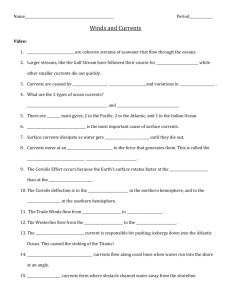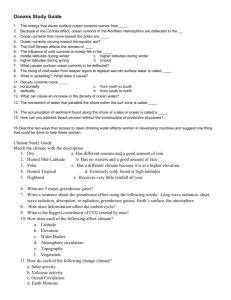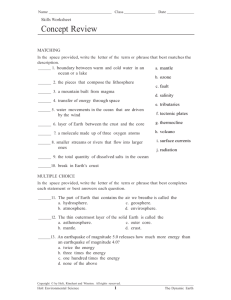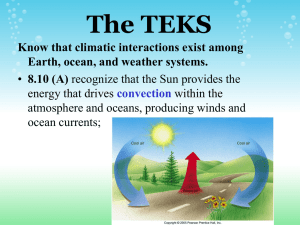Topography and Oceans - stpats-snc2p-2012
advertisement
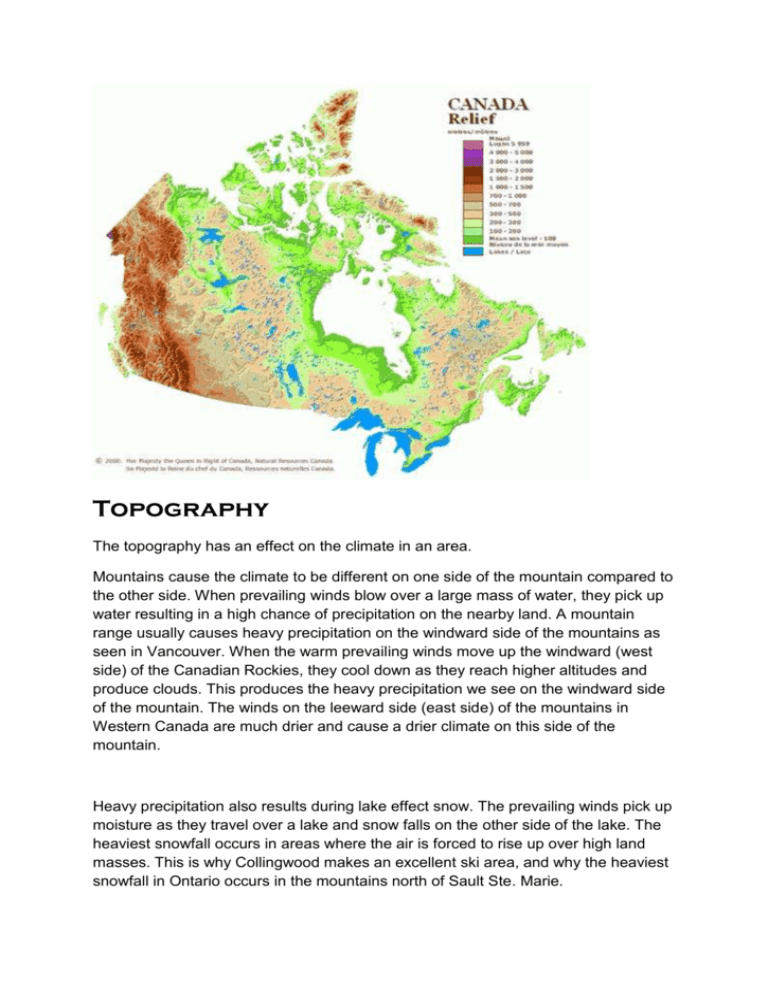
Topography The topography has an effect on the climate in an area. Mountains cause the climate to be different on one side of the mountain compared to the other side. When prevailing winds blow over a large mass of water, they pick up water resulting in a high chance of precipitation on the nearby land. A mountain range usually causes heavy precipitation on the windward side of the mountains as seen in Vancouver. When the warm prevailing winds move up the windward (west side) of the Canadian Rockies, they cool down as they reach higher altitudes and produce clouds. This produces the heavy precipitation we see on the windward side of the mountain. The winds on the leeward side (east side) of the mountains in Western Canada are much drier and cause a drier climate on this side of the mountain. Heavy precipitation also results during lake effect snow. The prevailing winds pick up moisture as they travel over a lake and snow falls on the other side of the lake. The heaviest snowfall occurs in areas where the air is forced to rise up over high land masses. This is why Collingwood makes an excellent ski area, and why the heaviest snowfall in Ontario occurs in the mountains north of Sault Ste. Marie. Oceans All of the water on the Earth is part of a layer called the hydrosphere. The Earth's surface is covered with approximately 70% water in the form of oceans, lakes, streams, and sheets of ice; and 30% of the Earth's surface is land. The salty ocean water makes up about 97% of the water on the Earth. Did you know? Did you know that Canada has almost 10% of the world's supply of fresh water? Of the approximate 35 million km3 of fresh water on Earth, about 24.4 million km3 are in the form of glacial ice, permafrost, or permanent snow. When the water in the ocean moves in one general direction, it forms a current. Ocean currents have a huge impact on the climate of the nearby land. Ocean currents can be produced when the Sun's energy heats up the air above the water producing winds. The wind blows over the surface of the water causing it to move. Ocean currents are also affected by differences in density of the water. The air above the ocean heats up and rises (less dense) and then cooler air that is denser, falls. For example the cold, denser Arctic water sinks and moves towards the equator. The warmer, less dense water at the equators will rise and move towards the Arctic forming a current. Warm ocean currents carry warm, moist air above the water. These areas are more likely to have clouds develop as a result of the additional moisture in the air. The warm ocean currents affect the climate of landmasses they flow past by producing more precipitation and warmer temperatures in these regions. Cold ocean currents create cool, dry air above them. The landmasses close to these currents will usually have drier and cooler conditions. Heat Sinks Both the atmosphere and hydrosphere are made up of heat sinks that hold energy. An object that is a good heat sink will hold the energy similar to how a kitchen sink can hold water. Rocks and soil are not good heat sinks because they conduct heat very slowly through their materials. The oceans are good heat sinks since they can transfer the energy from the Sun fairly quickly by using convection currents. The transfer of solar energy by convection currents allows heat energy to be distributed deeper into the ocean waters. Also, water has a high capacity which means it can hold on to its heat. It takes water a longer time to heat up, but it also takes a longer time for the water to cool down. This can be seen in the weather related effect called lake-effect snow. For example, Lake Superior takes a long time to cool down and freeze in the winter. As prevailing winds move from west to east across the lake, they pick up moisture from the water. When the winds reach the east side of the lake, the air temperature is cooler over the land resulting in the moisture in the clouds to fall as snow. The west side of Lake Superior has a higher amount of snowfall than the east side of the lake due to the direction of the winds and the moisture picked up from the lake. Land is a poor heat sink compared to water, which is a good heat sink. This results in the land cooling off quicker than the water. Did you know? Did you know that Lake Superior is the largest freshwater lake by surface area in the world? It totally freezes over about once every 20 years. Almost all of the water moisture in the atmosphere is located in the troposphere layer. This is the layer of the atmosphere where all of the weather systems take place. Convection currents in fluids (water or air) are formed as a result of heat. Convection currents are created when the warm air that is less dense rises and the cooler air that is denser, falls. Convection currents in the atmosphere help to distribute the energy from the Sun. Moist air is less dense than dry air; therefore areas with air that is more moist will form more convection currents. Birds can often times be seen floating in the air above the convection currents created over water or land. The giant thunder clouds (cumulonimbus clouds) that you see in the summer are caused by convections carrying warm moist air to high altitudes.



